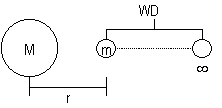GRAVITATION
gravitational field: region (3-D) where a gravitational F is experienced
Newton's Law of gravitation: 'Every particle of matter in the universe attracts each other particle w/ a gravitational F that is directly proportional to the product of the masses of the particles and inversely proportional to the square of the dist bet them'

F ∝Mm/r2
=> F = GMm/r2
[G = gravitational const: 6.672 x 10- 11Nm2/kg2,
r = dist bet obj,
m = mass of small obj,
M = mass of massive obj, eg Earth, Sun]
Newton's law: eg. for an inverse square law
Gravitational forces: -always attract, -v.v.weak (unless at least 1 obj of planetary mass or more)
Gravitational field strength, g (at a pt) = gravitational F per unit mass (acting at that pt)

g = F/m
g: vector, variable (near Earth surface ~const: v.v. small change => assumed const, 9.81N/kg)
F = GMm/r2
g = F/m = GMm/mr2 = GM/r2
[M = mass of other,massive obj => 'g' doesn't depend of mass of obj, m]
Earth gravitational field strength

at Earth surface: g0 = GM/R2 [M = mass of Earth, R = radius of Earth]
above Earth surface: g = GM/r2 [r = dist from Earth centre]
GM = g0R2
g = GM/R2
=> g = g0R2/r2 => dist from Earth ^, g decreases
at Earth's centre: g = 0: mass pulled equally in all dirn => FR = 0
GPE: WD bringing obj from infinity to pt (dist r from centre of big mass, M) (depends on mass)
Gravitational potential (at a pt): WB bringing a unit mass from infinity to pt (dist r from M)
φ/V = W/m = GPE/m
at infinity: V = 0, elsewhere: v = -ve
gravity = F of attraction, WD by mass as it moves from infinity > pt

If Δr is v.v.small: uniform field > F ~const (same dirn + mag)> g ~const (F=mg)
ΔW = -FΔr
F = mg => ΔW = -mgΔr [work done is -ve as it is done by obj]
ΔV = ΔW/m => ΔV = -gΔr => g = -ΔV/Δr [uniform field]
non-uniform field: g = - dV/dr
g = GM/r2


g0 = GM/R2
V = -GM/r
V = -g0R2/r (r = dist bet 2 obj)
[V0 = -g0R (R = radius of Earth)]
Escape speed, vesc: speed at which obj must leave a planet's surface in order to escape the gravitational field (obj > ∞)
loss KE = gain PE
½ mv2 - 0 = 0 - (-GMm/R)
=> v2 = 2GM/R
F = mg = GMm/r2
=> g0 = GM/R2
=> GM/R = g0R
=> v2 = 2g0R
Circular orbits
centripetal F provided by gravitational F:
F = mv2/r = GMm/r2
=> v2 = GM/r (speed only depends on radius + M, not 'm')
g0 = GM/R2 (R = Earth's radius)
=> GM = g0(R)2
=> v2 = g0(R)2/r
F = GMm/r2 = mω2r
=> GM/r3 = ω2 = (2π/T)2 = 4π 2/T2
=> T2/r3 = 4π 2/GM
=> T2 = (4π 2/GM) r3
=> T2 = k r3
=> T2∝ r3 (T ∝ r1.5; r ^,T ^)
4π 2/GM: const for all obj orbiting large mass M (=> T2/r3 = const)
Kepler's 3rd Law: T2 ∝ r3 (T:T of planet, r: dist from Sun)
Geostationery orbit: orbit w/ T = T of Earth's rotation = 24h
-satellite appears stationery in sky, same place at all times (rel to pt)
-easy to relay info bet satellite & Earth
Weightlessness: due to person & floor moving w/ equal acc (same mag. + dirn)
-contact F w/ floor = 0N (same if in zero gravity)
Back to 'A' level notes index
Back to notes index





